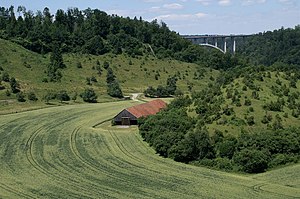Neckar valley between Rottweil and Sulz
|
FFH area "Neckar Valley between Rottweil and Sulz"
|
||
|
NSG Neckarburg near Rottweil |
||
| location | Rottweil district , Zollernalbkreis , Baden-Württemberg , Germany | |
| WDPA ID | 555522000 | |
| Natura 2000 ID | DE-7717-341 | |
| FFH area | 21.96 km² | |
| Geographical location | 48 ° 16 ' N , 8 ° 36' E | |
|
|
||
| Setup date | January 1, 2005 | |
| administration | Regional council Freiburg | |
The Neckartal FFH area between Rottweil and Sulz is located in the south of Baden-Württemberg and is part of the European Natura 2000 network of protected areas . It was designated in 2005 by the Freiburg Regional Council.
location
The 2197 hectare Neckar Valley nature reserve between Rottweil and Sulz is located in the natural areas of the Obere Gäue and the southwestern Alb foreland . The area is located in the Rottweil district with the communities of Bösingen , Dietingen , Epfendorf , Oberndorf am Neckar , Rottweil , Sulz am Neckar , Villingendorf and Vöhringen and in the Zollernalb district with the Rosenfeld community .
Protection purpose
Habitat types
The following habitat types according to Annex I of the Habitats Directive occur in the area:
| EU code |
* | Habitat type (official name) | Short name |
|---|---|---|---|
| 3260 | Rivers of the planar to montane level with vegetation of the Ranunculion fluitantis and the Callitricho-Batrachion | Running waters with flooding aquatic vegetation | |
| 5130 | Formations of Juniperus communis on limestone heaths and lawns | Juniper Heath | |
| 6110 | * | Gap basophilic or lime pioneer lawn (Alysso-Sedion albi) | Lime pioneer lawn |
| 6210 | * | Near-natural dry lime lawns and their stages of shrubbery (Festuco-Brometalia) (* special stands with remarkable orchids) | Lime grassland - orchid-rich stands * |
| 6230 | * | Species-rich montane grass grass (and submontane on mainland Europe) on silicate soils | Species-rich bristle grass lawn |
| 6430 | Moist tall herbaceous vegetation of the planar and montane to alpine level | Moist tall herbaceous vegetation | |
| 6510 | Lean lowland hay meadows (Alopecurus pratensis, Sanguisorba officinalis) | Lean, lowland hay meadows | |
| 7220 | * | Tufa springs (cratoneurion) | Tufa springs |
| 7230 | Lime-rich fens | Lime-rich fens | |
| 8160 | * | Calcareous debris heaps of the colline to montane level of Central Europe | Lime debris heaps |
| 8210 | Limestone cliffs with crevice vegetation | Limestone cliffs with crevice vegetation | |
| 8310 | Caves that are not open to tourists | Caves and balms | |
| 9130 | Woodruff beech forest (Asperulo-Fagetum) | Woodruff beech forest | |
| 9180 | * | Tilio-Acerion canyon and slope mixed forests | Mixed ravine and hillside forests |
| 91E0 | * | Alluvial forests with Alnus glutinosa and Fraxinus excelsior (Alno-Padion, Alnion incanae, Salicion albae) | Alluvial forests with alder, ash, willow |
Species inventory
The following types of community interest exist in the area:
| image | EU code |
* | Art | scientific name | Species group |
|---|---|---|---|---|---|

|
1032 | Small river mussel | Unio crassus | Shellfish | |

|
1163 | Bullhead | Cottus gobio | Fish and round mouths | |

|
1323 | Bechstein's bat | Myotis bechsteinii | Mammals | |

|
1324 | Great mouse ear | Myotis myotis | Mammals |
Contiguous protected areas
The following nature reserves are part of the FFH area:
See also
Web links
- Profile of the FFH area Neckartal between Rottweil and Sulz in the protected area directory of the LUBW
- Standard data sheet for the FFH area "Neckar Valley between Rottweil and Sulz"
- Regional Council Freiburg (Ed.): Maintenance and development plan for the FFH area 7717-341 “Neckar valley between Rottweil and Sulz” and the bird protection areas 7617-401 “Brandhalde” and 7717-401 “Schischemtal” . edited by Thomas Breunig - Institute for Botany and Landscape Science. December 1, 2006 (135 pages, baden-wuerttemberg.de [PDF]).
- Information board at the entrance to Irslenbach

